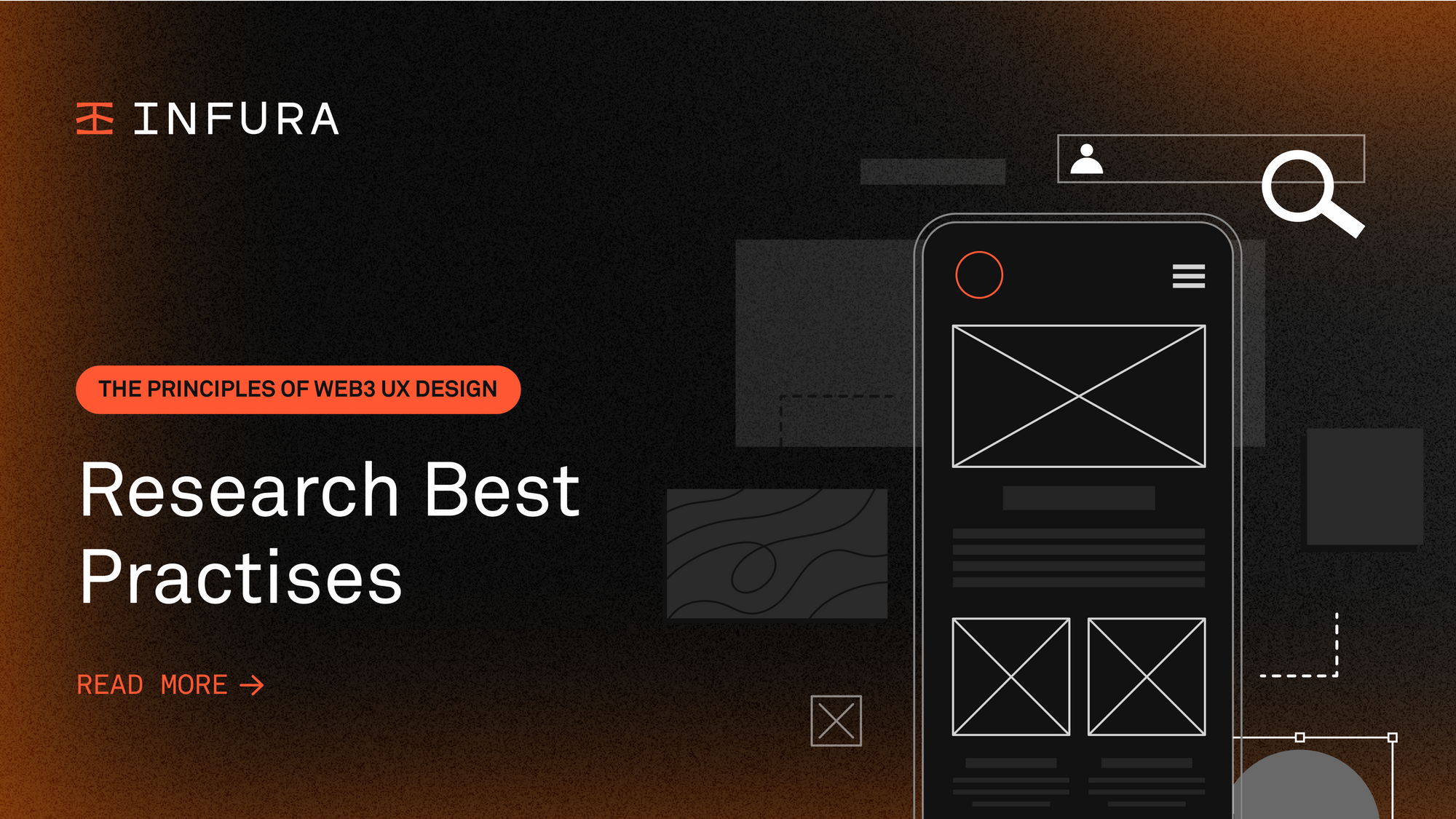The Principles of Web3 UX Design Part 1: Research Best Practices
This article delves into best practices for building decentralized products for the next iteration of the internet. It also highlights how MetaMask Snaps contributes to this endeavor.

This article delves into best practices for building decentralized products for the next iteration of the internet. It also highlights how MetaMask Snaps contributes to this endeavor.
UX design for decentralized protocols is an undiscovered and undefined discipline. The design principles used in web2 software development don’t apply to blockchain-based apps that require tokenomics, governance, and above all communities to thrive.
Asking the right research questions and choosing the right research method is crucial to achieving product-market fit and scalability of dapps and communities. Here are the best practices we’ve learned for UX design research in web3.
Choose the right research methods to answer your UX design questions
In an emergent industry like web3, knowing who your customers are can be challenging. As the world continues to adopt blockchain technology, your knowledge and understanding of who your target audience could constantly change.
So how can you not lose sight of who you’re building for in order to create the perfect design of your product and service?
Through continuous research and iterations.
This best practice, while not unique to web3, is essential in UX design since user adoption is growing faster than in traditional tech. Continuous research and iterations help you stay updated about who your customers are, how to investigate the experiences of end-users, and how to measure impact.
Research as a discipline is a continuous process that helps with product improvements and iterations over time. If you’re looking to learn more about unknown areas of your product, customers, or potential customers, you’re performing discovery research. While some discovery research might not require deep contextual information, others may.
For example, if you’re looking to measure the current design experience of your product, a short survey could easily obtain such insights. On the other hand, if you’re looking to understand the why behind current design experience ratings, then follow-up remote interviews are more equipped to help you uncover deeper insights.
Remote interviews, contextual inquiries, and diary studies are uniquely positioned to uncover the why behind any research or business questions. Surveys, content testing, concept testing, and A/B testing are uniquely positioned to uncover the “what” behind any research question.
Common UX research questions asked in Web3
Spoiler alert: research questions asked in web3 are no different than those asked in web2 because they’re all contextual and specific to the industry a researcher or business operates in. Research questions in web3 are web3 specific.
Some questions might focus on various blockchains; others may revolve around protocols. However, it’s important to note that research questions are context-specific.
Additionally, research questions are often reframed business questions. For example, your product team might have a business question like, “What new blockchains should we support?” Reframing this business question to a research question then evolves into:
- What blockchains are developers most interested in building on?
- Why are developers interested in this blockchains?
- What value would supporting other blockchains provide builders?
It’s important to gain alignment on your research questions from the stakeholders that you’re working with before starting an investigation. The last thing any researcher wants to do is investigate things that their stakeholders do not agree with. Save yourself time and effort by making sure your research questions align with business needs.
Web3 UX is ours to define
Researchers are well-positioned to reframe business questions to research questions, create plans of investigation, and provide insights to help product and protocol design teams make data-driven decisions.
There’s still a lot to learn in web3, especially as the rest of the world adopts blockchain technology. Choosing the right research methods to address research questions and asking the right research questions are essential.
Research is a continuous and iterative process. As we learn more on our journey of supporting developers of all kinds, we’ll continue to share lessons learned and best practices for UX research and design in web3. Keep an eye out for part two of this series.
Three ways MetaMask Snaps enhances Web3 UX
Before diving into how MetaMask Snaps can enhance your web3 dapp’s UX, let's first clarify what MetaMask Snaps are. MetaMask Snaps, also known as ‘Snaps’, are JavaScript applications built by third-party developers that modify and enrich the wallet experience for MetaMask users by adding various features and functionalities.
Snap’s mission is to decentralize the development of the MetaMask wallet. Given the numerous protocols and projects launching daily, a decentralized approach is vital. The existing development team identified that an effective way to keep the MetaMask wallet updated with new protocols is to grant developers the ability to integrate support for their projects directly into MetaMask itself. To delve deeper into Snaps or to learn how to create your first Snap, click here.
Now that we've established what Snaps are, here are three ways Snaps can elevate your web3 dapp’s UX:
- Interoperability: A unified wallet for multiple blockchains: The rapidly evolving web3 landscape often requires users to juggle multiple wallets, especially if they're engaging with different blockchains like Ethereum, Bitcoin, Solana, and others.
Instead of downloading and mastering various wallets, wouldn't it be easier to have one that does it all? MetaMask Snaps addresses this issue. With the help of third-party developers, MetaMask Snaps can expand the wallet's functionality, allowing it to cater to users engaging with non-EVM chains in a secure manner. - Authentication: Streamlined sign-ins for dapps: A notable difference between web2 and web3 applications is the way user authentication is handled. In web2, users are required to provide their email and passwords or accept various cookies and terms. In contrast, the web3 experience is simple and straightforward: users only need to connect their wallet. MetaMask Snaps enhances this by introducing a new set of APIs.
These APIs allow developers to explore innovative methods and further simplify interactions and authentication on dapps using shared decentralized identities and verifiable credentials. - Security: Enhanced transaction insights: A significant concern in web3 today is phishing attacks, where users sign transactions without fully understanding their implications. To combat this, MetaMask Snaps implements measures such as checking recipient addresses against known phishing databases and simulating transactions to determine their potential outcomes, ensuring users have a clearer picture before confirming any action.
Metamask Snaps is a great way to introduce wallet-centric UX upgrades for your protocol and dapp. To learn more about building a Snap, visit this website. If you have questions or ideas, chat with us on GitHub or the Consensys Discord's snaps-dev-metamask channel.


